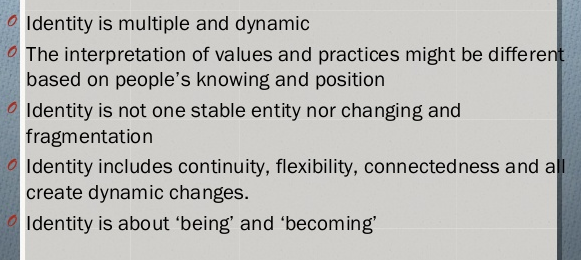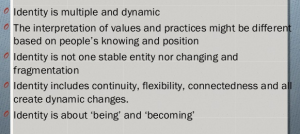This week we delved into the language teacher identity through Varghese et. al’s work on Theorizing Language Teacher Identity.
My Self- Identity: Social Identity Theory
In terms of social identity as a NEST in China, I have been assigned a higher status (US being the highest) where there is constant debate about which accent is the most popular. I reject this assigned identity because my place of birth can never fully explain the complex person that I am, and because the images and ideals (of ‘Britishness’) that are projected on to me are all but stereotypes. Whenever I come across someone discriminating against accents, I try to remind them that in any big city they go (in the West) it is likely to be multi-cultural, and, by default, full of colourful accents far removed from the Queen’s English. Thus being exposed to different accents is beneficial for future interactions abroad. Social identity theory recognises the membership of individuals in many groups (p25). Indeed, I do feel I choose when and where I want to be British or European. And sometimes I even pretend to be French or Brazilian (!), proving that membership in one group may be at times more salient than membership in another (p25). From a social perspective, then, my claimed identity if that of global citizen, dramatically liberating myself from the socio-economic overtures my birthplace often attracts.
I also reject the idea the superiority of NESTs over NNESTs (or NNS of a target language over NS of a target language). As we discussed in our online meeting, NNESTs, in many respects actually have the edge, having gone through the process of learning the language themselves, usually to a very high proficiency. Indeed, any language teacher who has learnt another language, is likely to make more informed decisions about classroom activities. So although in Study 1(Johnson), we see a teacher struggling with her conflicting identities as student and teacher, I actually see some aspects of the dual role as quite positive.
My Self- Identity: Situated Learning Theory
Lave and Wagner (1991) suggest that learning and understanding occur as people participate in activities where they become increasingly active participants (p29). Since its launch in 2012, I have been an active member of Cambridge English Teacher. This online professional development resource has contributed significantly to the construction of my identity as an autonomous learner, and an informed ‘professional’ teacher. Through this website I have direct access to wide-range of teaching and learning materials. Whereas this may be seen as ‘master’s (Varghese et al., 2005) generating knowledge for teachers, I do feel that we have the opportunity to co-construct and co-develop what we are learning via webinars on the latest EFL/ESL topics, in which we are encourage to ask questions, and through collaborative dialogue with fellow participants and industry ‘experts’ in the Forum.
My Self- Identity: Identity as Pedagogy
I relate to Morgan’s study of identity as pedagogy. I try to channel who I am, what I do and what I believe into my lessons. There is some skill involved as I navigate which topics are and are not taboo, but this is less of an issue know that I teach young learners. And besides, if the best way of teaching is understanding your students (character, learning style, linguistic abilities), then this implies a strong teacher-student relationship is needed, upon which learning can be based. It’s true, I seek to question and challenge. And therefore, I can see why this form of teacher identity may be seen as ‘dangerous’ (p35). I do consider myself lucky, though, to have such an influence on young minds, grading my language and ideology, in diplomatic fashion.
In sum, then, my complex and ever-changing language teacher identity seems to delicately weave through each of the three theories proposed in Varghese’s paper: “I teach, therefore I am!”
Key
NEST = Native English Speaking Teacher
NNEST = Non-Native English Speaking Teacher
NS = Native Speaker
NNS = Non- Native Speaker
Sources
Varghese, Morgan, Johnston and Johnson (2005), Theorizing Language Teacher Identity: Three Perspectives, and beyond, Journal of Language, Identity & Education, 4:1, 21-44


